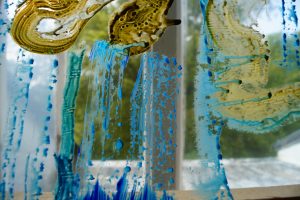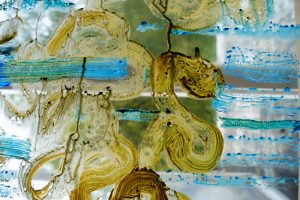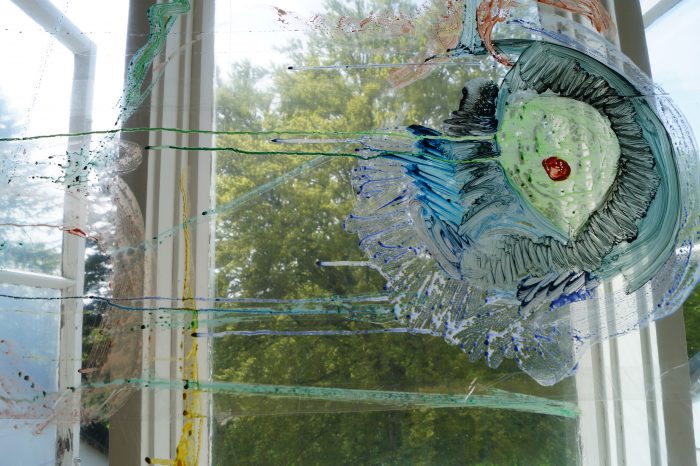Written by Mischa Mathys, The Formant
A few weeks ago a cryptic message arrived on social media, talking about a performance at Galleri Ram and a request; to document an exchange between the artists involved as they explain the ideas behind the project. The message came from Hilde Marie Holsen, a musician who I have interviewed on several occasions in the past, and whose music resonates with the avant garde of Jazz and electronica in Norway and beyond.
I’ve known Hilde since her debut album ASK, an album that was critically acknowledged the world over and established Hilde as a singular musical presence in her field. From her chosen instrument, the trumpet, she creates synthetic worlds from digital processes that drone and churn against an ambient backdrop where sorrow, mystery and the unfamiliar reside. Her performances are captivating, often in the presence of another notable musician-collaborator, creating special improvised performances that ingrain themselves in the moment.
Hilde meets me on a Monday evening in May, and she is joined by Tyra Fure Brandsæter, her collaborative partner for the upcoming performance at Galleri Ram as part of the Spaces Speak series on the the 6th of June. Tyra’s hands are covered in colourful splashes of paint, alluding to her chosen discipline, but not very forthcoming in how it will be incorporated into this upcoming performance. They explain they’ve just come from a rehearsal for this project and we dive right into conversation as they untangle the ideas and motives of the upcoming performance and just what it might entail…
Hilde Marie Holsen: I’m going to play and Tyra is going to paint. We did that together once before, about three years ago and it was really fun and we want to do it again. Tyra’s going to paint on plastic, like gladwrap while I play.
Tyra Fure Brandsæter: Yes, like thin plastic, instead of canvas. I know Hilde’s music really well now, so I thought I’d create a visual environment that will somehow connect to her music. I was thinking about music as being invisible and omnipresent, and I wanted to let the painting, «be in the air» in that way – an art as performance.
In the air… That’s where the plastic comes into it?
T: Yeah. It will also be reacting to these sound waves, vibrating constantly as an extension of movement from Hilde.
H: It’s also unique from the audience’s perspective, who will see the painting from behind as it is “performed”. When we did it the first time, we only saw Tyra’s back, and it was only when she moved that we could see what she was doing. In this next performance we’ll be able to see the painting come to life from different perspectives…
T: … and as it happens. I wanted to step back and feel more free.
Will it be an abstract expressionist kind of work with focus on the performance of painting?

T: Yes, for sure.
Tell me a bit about the origins of the original idea and the first performance.
H: It was during my first year of a masters course that I first thought of it. I had this plan during the early part of my studies that I wanted to explore a visual and musical dialogue or connection. I ended up doing something completely different for my masters, and then only got back to this idea some time after.
I asked Tyra to collaborate, because we had been at folkehøgskole together and she had been singer, so she had that musical background to work with.
Yes, Tyra tell me a bit about your background and how it informs this project.
T: I‘ve worked with music, art, dance and theatre, but in these last years I have focussed more on painting. I’ve always felt that I wanted to go into the direction of painting spontaneously, trying to capture the moment of the now. That has been more important to me than the final execution and ideal form. The process of painting I find more interesting than the painting itself.
Do you think working with Hilde, and your background in music, might inform your painting in a different way?
T: Yeah, and also when I paint in a more traditional sense on canvas, people have always suggested I paint movement. I’ve never really thought of it like that, and when I started to «perform» with painting, I realised that I’m more interested in the actual movement of life.
H: We also talk a lot about these subjects when we meet. We have these long conversations about movement and the different expressions of how they actually connect. The end-result, the figurative work holds no value, and Tyra actually just throws it away.
T: Yes, I’m finished at that point and it’s no longer art.
It’s a performance piece?
T: Yes exactly.
Do you have an image in mind before you approach a work like this with Hilde?
T: No. It’s completely blank. I am just trying to improvise. I know I have all this knowledge, I know I have all these experiences that can suddenly happen when I meet Hilde’s music. That’s what I think is so interesting about improvisation too, because you have all these tools and the art will suddenly happen if you find the right inspiration, like music.
Hilde, do you feed off the visual aspects that might inform the way you improvise differently?
H: In some sense. The first time we attempted it, I didn’t actually see much when we were playing together. I see more now, but I’m still not sure how much of it is reflected in my playing. It’s more like I sense Tyra’s movements. The discussions we have beforehand are very inspiring, in a sense that we start to recognise the things that transpire. Today for instance, during rehearsals Tyra had run out of space and in the end she was just sitting there, painting in the air, and imagining what was she was thinking brought about a connection, even across our different medias.
Do you think if you were to do it in isolation and every else about the circumstances remained unchanged, you’d have the same results?
H: It’s a similar feeling to playing live in front of people as opposed to just rehearsing for me. If you play in front of other people there’s a tension that exists, and when I play with Tyra it’s the same. She’s really focussed and that aides me in keeping my focus. It has some impact, but how much and in what sense is difficult to pin down.
T: Well for me: I’ve worked in my studio and listened to Hilde’s music before, conscious of the fact that the music has already been created. So the knowledge of this is happening now and the unpredictability of the thing makes for a very strong force in the focus.
H: I know it affects me musically, but how it affects me is impossible to put into words.
What have been the topics of discussion leading up to this project?
H: I think the first time we started talking about this project, Tyra was talking about concepts of movement, because she had just started doing research on dance theory. About a year ago I was also research on choreographers, so we had found some common ground on movement and ultimately we’ve tried to find ways to do the same in music and painting in that way.
Apart from that we started talking about the more logistical aspects of the work too, like painting on plastic, and some more abstract ideas, like painting in a circle with the audience in the middle, and how you would feel as an audience member packed in the middle of some gladwrap installation with Tyra just dancing around you.
T: I really like how the different senses are connected, and about creating situations that you can use as many senses as possible in a way they are very connected.
If you were to separate the two works as final execution afterwards, do you think it will make a huge difference for the viewer and/or listener?
T: Yes, for sure.
H: They will be two completely different pieces.
What if I were to play some piece of random muzaik in the same context, Tyra?
T: It would be completely different. I have a personal relationship to Hilde’s music, and I also feel incredibly comfortable that what I show in my colours and forms connect with Hilde’s music. Hilde also forces me to be more kind in a way. (Laughs) Hilde’s music is like it’s own universe with so many different emotions and tactile sounds. It’s like being a child again.
I know Hilde you record all your live shows, but with Tyra disposing of the gladwrap work, do you put any value on the music that results?
H: If I don’t like the recording after the live show, I am inclined to delete it. I did for instance take a picture of Tyra’s artwork, so if she would like to see it, it exists somehow. Do you throw away everything you do, Tyra?
T: No, but in a way I like to get rid of it, because I don’t need it anymore.
It’s really interesting, because it completely does away with the idea of art as a commodity that we’ve perpetuated for so many years now.
T: When I went to art school so many of my teachers were always nagging me about this very thing. They couldn’t understand the concept of the act of art as its own intrinsic value. They would take their time on every small detail in the scope of the ultimate execution and for me it’s not about that; it’s about the art of painting.
H: That sounds very familiar to the way composers work. In the studio I can’t reflect on which choice is better. For me it is very much about: «ok these are my choices» and if they don’t work out the piece doesn’t work out. So I’ll just throw away the entire piece. It’s just different working methods and the way people are creative.
To put it into perspective there is this story about a Chinese emperor who had commissioned an artist for a painting. The artist, accepting the commission, said it would be done in four years, but when the emperor returned four years on, the painting was still not done. The painter asked for another four years, and the emperor, although somewhat perplexed, allowed the new deadline. After another four years it still wasn’t not done, and the artist apologetically asked for yet another extension of four more years. The emperor although impatient allowed the extension yet again, and after another four years the emperor finally arrived to collect his work. The artist offered his employer some tea and while the emperor sipped at his tea the artist took to a blank canvas and painted the most lively painting ever. The emperor was notably impressed, but confused and felt a bit mislead. The painter then showed him to another room where the same image was in duplicate all over the room, and the painter explained; it took me twelve years of practise to get to that one perfect painting.
It’s the same idea behind improvisation, because we’re rehearsing a lot, and thinking a lot about what we’re doing to be able to do it in the now.
So each live performance is a step closer to that perfect moment. But in improvisation that moment never exists though, because there’s always the next performance.
T: Yes, but it’s about the idea, it’s about a longing. I was also thinking of it as a longing of being connected – doing something at the same times as this perfect moment. It’s kind of an entropy of being together, as different parts connecting as one. That, I feel very strongly in this project. It’s about the hope of something.
Are you ever surprised by the end result?
H: At least for me it was very interesting to see how the painting developed on plastic, and also after it was completed. After the music finished there was nothing more there, but we could at least stand in front of the painting, and watch it and discuss elements of the painting that we could relate to the music. It’s like I’m telling a musical story and you’re painting the same story, and although it doesn’t quite happen at the same time, you can still get the idea of what the story contained.
T: You can really see distinct motifs and how they might correlate to something in the music.
Is it something that you can trace back to something concrete or something that has some revisionist history associated with it?
H: I believe with certain elements it can work as a metaphor, so even though it happened in the context of a musical performance, I think afterwards it can relate to a memory or the same story, told in a different way. For instance if a musical event happened early and a visual event happened some time later in the future, it can relate to a formal of structure. It’s not like we are following each other’s movement, but we are contributing to the other’s media.
Why now, and why this performance?
H: It’s a concert series called Spaces Speak, which is the brainchild of Joachim Blatman in collaboration with Notam at Galleri Ram. Joachim asked me in January to do something for this series with an artist. The concept was perfect to explore the shows I had done with Tyra before, even further.
Is it something you intend to do more of the future?
H: We have been talking about that and it’s something we definitely want to explore more in the future, and that’s part of the reason we wanted to have some proper documentation around it. We have some larger ideas, but we didn’t have the time and the resources to do it, but hopefully there will be more.
T: I really feel that this is only the beginning because it’s really inspiring working with Hilde.

